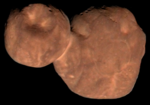|
2019 UN13
2019 UN13 is a small near-Earth asteroid roughly 1–2 meters in diameter. Even though the asteroid was in the night sky for months, it was fainter than the sky survey limit of apparent magnitude 24 until 29 October 2019 when the asteroid was two million km from Earth.[7] It was discovered on October 31, 2019, passing 6,200 km above Earth's surface.[8][9] 2020 QG and 2011 CQ1 are the only asteroids known where the nominal orbit passed closer to the surface of Earth.[6] Other asteroids that passed very close to Earth include 2004 FU162, 2018 UA, and 2019 AS5. An impact by 2019 UN13 would be less significant than the 2018 LA impact. 2019 flyby
Orbit changesThe close approach to Earth lifted the asteroid's aphelion point (furthest distance from the Sun) from 1.33 AU (inside the orbit of Mars) to 2.06 AU (near the edge of the inner asteroid belt). The approach changed the orbit from an Aten asteroid with a semi-major axis less than 1 AU to an Apollo asteroid with a semi-major axis greater than that of the Earth (> 1 AU).
With the new orbit, 2019 UN13 will come to perihelion 0.83 AU from the Sun on 15 December 2019. Without perturbations, the previous orbit would have come to perihelion in January 2020. FutureThere is a small chance the asteroid will pass 0.0001 AU (15,000 km) from Mars on 26 October 2023.[3] There is also a 1 in 3 million chance the asteroid will impact Earth on 1 November 2111.[4] See also
References
External links
|
||||||||||||||||||||||||||||||||||||||||||||||||||||||||||||||||||||||||||||||||||||||||||||||||||||||||||||||||||||||||||||||||
Portal di Ensiklopedia Dunia



